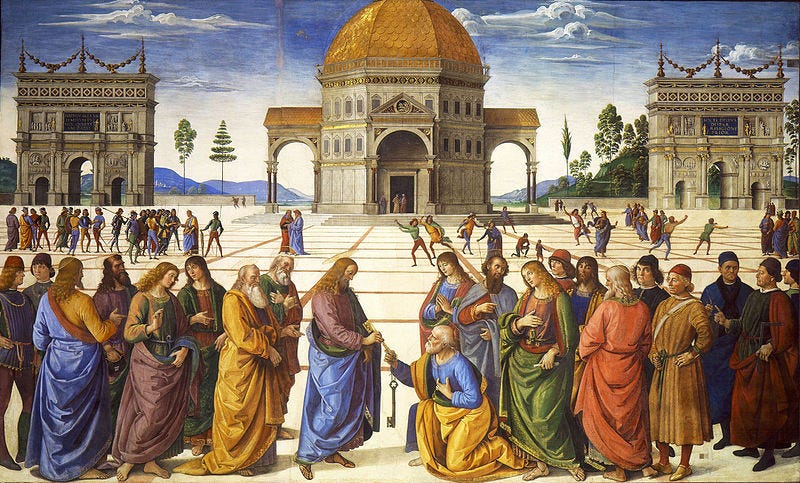A Foundation of Rock: The Feast of the Chair of St. Peter
Saturday, February 22nd readings reflection: Feast of the Chair of Saint Peter, Apostle
Today is the Feast of the Chair of St. Peter, which commemorates the papal authority and line of succession from St. Peter, the first pope of the Catholic Church. In today’s Gospel, we hear Jesus granting this authority to St. Peter: “And I say to thee: That thou art Peter; and upon this rock I will build [M]y church, and the gates of hell shall not prevail against it. And I will give to thee the keys of the kingdom of heaven” (Mt 16:18-19 DRB).
The name Peter means rock. In giving this name to St. Peter, Jesus was establishing him as the visible foundation of His Church. In his commentary for this passage in the Douay-Rheims Bible, Bishop Challoner wrote, “[St. Peter] should be a rock indeed, of invincible strength, for the support of the building of the [C]hurch; in which building he should be, next to Christ [H]imself, the chief foundation stone, in quality of chief pastor, ruler, and governor; and should have accordingly all fulness [sic] of ecclesiastical power, signified by the keys of the kingdom of heaven.”
In the Old Testament, the duties of the high priest at the Temple involved being gatekeeper. The high priest alone received the key of the sanctuary; he alone possessed authority over the entire Temple. The Levitical high priests had a line of succession; the succeeding high priest assumed the responsibilities and authority of his predecessor, including the role of Temple gatekeeper.
The Jewish Apostles and early Jewish converts to Christianity would have immediately recognized these parallels between the Levitical high priesthood and Christ’s conferral of authority on St. Peter. Christ did and said nothing by accident; everything that He said and did was deliberate with many layers of meaning and symbolism. Thus He deliberately conferred authority on St. Peter in a manner parallel to that of the Levitical high priesthood to show that He was establishing St. Peter as high priest of His Church.
Just as the Levitical priesthood did not end with the death of Aaron but rather continued on in a line of successors, so too the Catholic papacy has continued in an uninterrupted line of successors to St. Peter. In the ancient Greek of the Bible, the same term petra is used when referring to St. Peter in today’s Gospel and to the rock on which the wise man builds his house in Christ’s parable (see Lk 6:48). Just as the flood could not shake the house whose foundation was built upon rock, so too the Gates of Hell cannot prevail against the Catholic Church. The Catholic Church is the oldest existing institution. Other institutions founded by mortal men have come and gone. Other religious sects have broken off from the Catholic Church; some continue to exist in some form today, while others have ended, but the Catholic Church alone stands as the bulwark of truth, whom the Holy Ghost guides in all truth (cf. Jn 16:18). She is the sole institution against whom the Gates of Hell have no power, for her divinely-instituted foundation is built on rock.
Our Holy Father Pope Francis has been in the hospital for over a week due to serious health issues. On this Feast of the Chair of St. Peter, may we pray for our Holy Father, who is the successor to St. Peter and the visible head of the Catholic Church on earth. May God shower him with graces on this wonderful feast and guide him in all truth.



Interesting. I’m not accustomed to the high priest connection & Peter. I’d love to learn more about it.
The sources I’ve read connect Matthew 16:18 with the Davidic Kingdom via Isaiah 22:22. Peter is the viceroy of sorts to Jesus the eternal Davidic King. The etymology of Vicar is related to the word vicarious. Peter is the, by definition, the substitute/agent of Jesus’ authority.